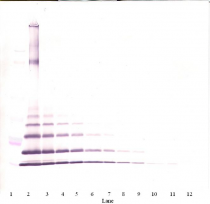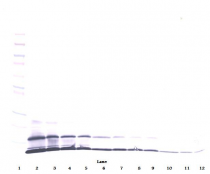ARG66048
anti-CCL8 / MCP2 antibody (Biotin)
anti-CCL8 / MCP2 antibody (Biotin) for ELISA,Western blot and Mouse
Overview
| Product Description | Biotin-conjugated Rabbit Polyclonal antibody recognizes CCL8 / MCP2 |
|---|---|
| Tested Reactivity | Ms |
| Tested Application | ELISA, WB |
| Host | Rabbit |
| Clonality | Polyclonal |
| Isotype | IgG |
| Target Name | CCL8 / MCP2 |
| Antigen Species | Mouse |
| Immunogen | E. coli derived recombinant Mouse CCL8 / MCP2. (GPDKAPVTCC FHVLKLKIPL RVLKSYERIN NIQCPMEAVV FQTKQGMSLC VDPTQKWVSE YMEILDQKSQ ILQP) |
| Conjugation | Biotin |
| Alternate Names | SCYA10; MCP2; Small-inducible cytokine A8; 6-76; Monocyte chemotactic protein 2; HC14; SCYA8; C-C motif chemokine 8; MCP-2; Monocyte chemoattractant protein 2 |
Application Instructions
| Application Suggestion |
|
||||||
|---|---|---|---|---|---|---|---|
| Application Note | * The dilutions indicate recommended starting dilutions and the optimal dilutions or concentrations should be determined by the scientist. |
Properties
| Form | Liquid |
|---|---|
| Purification | Purified by affinity chromatography. |
| Buffer | PBS (pH 7.2) |
| Concentration | 1 mg/ml |
| Storage Instruction | Aliquot and store in the dark at 2-8°C. Keep protected from prolonged exposure to light. Avoid repeated freeze/thaw cycles. Suggest spin the vial prior to opening. The antibody solution should be gently mixed before use. |
| Note | For laboratory research only, not for drug, diagnostic or other use. |
Bioinformation
| Database Links | |
|---|---|
| Background | This antimicrobial gene is one of several chemokine genes clustered on the q-arm of chromosome 17. Chemokines form a superfamily of secreted proteins involved in immunoregulatory and inflammatory processes. The superfamily is divided into four subfamilies based on the arrangement of N-terminal cysteine residues of the mature peptide. This chemokine is a member of the CC subfamily which is characterized by two adjacent cysteine residues. This cytokine displays chemotactic activity for monocytes, lymphocytes, basophils and eosinophils. By recruiting leukocytes to sites of inflammation this cytokine may contribute to tumor-associated leukocyte infiltration and to the antiviral state against HIV infection. [provided by RefSeq, Sep 2014] |
| Function | Chemotactic factor that attracts monocytes, lymphocytes, basophils and eosinophils. May play a role in neoplasia and inflammatory host responses. This protein can bind heparin. The processed form MCP-2(6-76) does not show monocyte chemotactic activity, but inhibits the chemotactic effect most predominantly of CCL7, and also of CCL2 and CCL5 and CCL8. [UniProt] |
| Calculated MW | 11 kDa |
| PTM | N-terminal processed form MCP-2(6-76) is produced by proteolytic cleavage after secretion from peripheral blood monocytes. |
Images (4) Click the Picture to Zoom In
-
ARG66048 anti-CCL8 / MCP2 antibody (Biotin) WB image
Western blot: 250 - 0.24 ng of Mouse MCP-2 stained with ARG66048 anti-CCL8 / MCP2 antibody (Biotin), under non-reducing conditions.
-
ARG66048 anti-CCL8 / MCP2 antibody (Biotin) standard curve image
Direct ELISA: ARG66048 anti-CCL8 / MCP2 antibody (Biotin) at 0.25 - 1.0 µg/ml results of a typical standard run with optical density reading at 405 - 650 nm.
-
ARG66048 anti-CCL8 / MCP2 antibody (Biotin) WB image
Western blot: 250 - 0.24 ng of Mouse MCP-2 stained with ARG66048 anti-CCL8 / MCP2 antibody (Biotin), under reducing conditions.
-
ARG66048 anti-CCL8 / MCP2 antibody (Biotin) standard curve image
Sandwich ELISA: ARG66048 anti-CCL8 / MCP2 antibody (Biotin) as a detection antibody at 0.25 - 1.0 µg/ml combined with ARG66047 anti-CCL8 / MCP2 antibody as a capture antibody. Results of a typical standard run with optical density reading at 405 - 650 nm.









